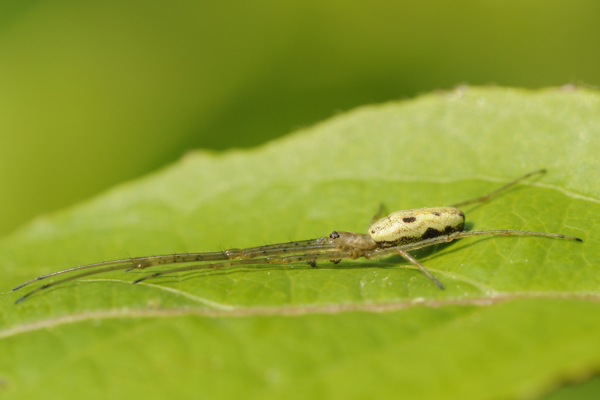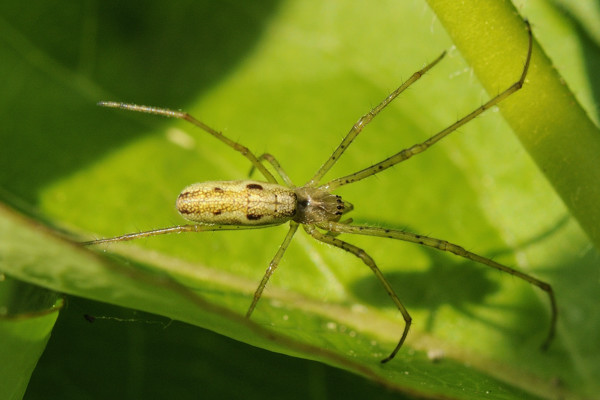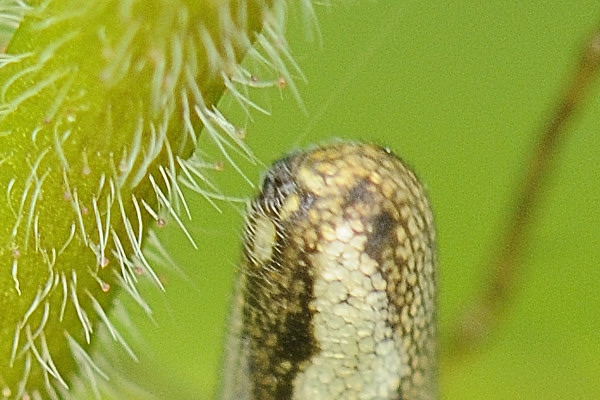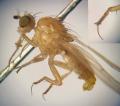Diptera.info :: Identification queries :: Other insects, spiders, etc.
|
Slender orb-weaver spider?
|
|
| nick upton |
Posted on 13-05-2010 18:20
|
|
Member Location: Wiltshire, UK Posts: 828 Joined: 12.03.10 |
Can anyone say if this is Tetragnatha elongata, maybe a male? > Make that T. extensa? Thanks Sundew. Wiltshire, southwest UK, 11.5.10 Body c 8mm nick upton attached the following image:  [144.44Kb] Edited by nick upton on 14-05-2010 10:22 Nick Upton - naturalist and photographer |
|
|
|
| Sundew |
Posted on 13-05-2010 22:17
|
|
Member Location: Berlin and Baden-Württemberg, Germany Posts: 3938 Joined: 28.07.07 |
Seems to be a Tetragnatha, but isn't T. elongata an American species? I couldn't find a similarly coloured animal in my atlas of European spiders, and also the website http://www.xs4all...thidae.htm gave no results. So one of the eight Tetragnatha species of Northwest Europe... |
|
|
|
| nick upton |
Posted on 14-05-2010 10:21
|
|
Member Location: Wiltshire, UK Posts: 828 Joined: 12.03.10 |
Ooops, yes. I meant could it be Tetragnatha extensa? Same meaning, different Latin word... I've seen lots of pics of T. extensa and the patterning looks different in just about every one, but hoped a spider expert might know for sure from some subtle detail I'm ignoring.
Nick Upton - naturalist and photographer |
|
|
|
| tim worfolk |
Posted on 14-05-2010 11:29
|
|
Member Location: Devon, England Posts: 737 Joined: 05.05.09 |
The subtle detail you need to see is the female epigyne - I suppose a detailed close-up of the underside might be enough. cheers Tim |
|
|
|
| nick upton |
Posted on 14-05-2010 12:12
|
|
Member Location: Wiltshire, UK Posts: 828 Joined: 12.03.10 |
OK, thanks Tim. I only got one other view, which I doubt will help at all; I got no rear end underside views, but will look out for this spider again and will try to engineer that angle somehow. I guess it's Tetragnatha sp. for now.
nick upton attached the following image:  [101.14Kb] Nick Upton - naturalist and photographer |
|
|
|
| nielsyese |
Posted on 14-05-2010 16:19
|
|
Member Location: Yerseke, NL Posts: 2368 Joined: 13.02.09 |
Tetragnatha spec. |
|
|
|
| nick upton |
Posted on 14-05-2010 17:44
|
|
Member Location: Wiltshire, UK Posts: 828 Joined: 12.03.10 |
OK thanks. Will post an epigyne shot if I can get a decent one in case that helps to take it further.
Nick Upton - naturalist and photographer |
|
|
|
| Juergen Peters |
Posted on 14-05-2010 22:09
|
|
Member Location: northwest Germany Posts: 14332 Joined: 11.09.04 |
Nielsyese wrote: Tetragnatha spec.  Here in central Europe this would be Tetragnatha montana with little doubt (general impression, "wave" marking on sides, frequent ubiquist). Best regards, Jürgen -=-=-=-=-=-=-=-=-=-=-=-=-=-=-=-= Juergen Peters Borgholzhausen, Germany WWW: http://insektenfo... -=-=-=-=-=-=-=-=-=-=-=-=-=-=-=-= |
| nick upton |
Posted on 14-05-2010 22:28
|
|
Member Location: Wiltshire, UK Posts: 828 Joined: 12.03.10 |
Good call Juergen! That species is here in the UK and the patterning certainly looks right eg: http://www.bugsandweeds.co.uk/spiders.html This link also mentions how they are sometimes seen without a web (as I first saw this spider), but I have since found 2 on the same bush, stretched out on leaves, both with small webs nearby. This is the best photo I managed to get of the epigyne, but may not help as its a bit in profile and not super sharp. nick upton attached the following image:  [142.81Kb] Nick Upton - naturalist and photographer |
|
|
|
| Juergen Peters |
Posted on 14-05-2010 22:43
|
|
Member Location: northwest Germany Posts: 14332 Joined: 11.09.04 |
Hi, Nick! Thanks, but I doubt if even a highres pic of the epigyne would help much. The Tetragnatha species are normally identified by the chelicerae of the males only, because the epigynae are rather similar. Also at this time the animal may not be adult, yet. T. montana is one of the most frequent spiders here in the garden (and one of the most frequent everywhere), whereas T. extensa only occurs directly near water, and does not show that "wave" marking. They overwinter as young spiders in herbs and at trees, where they can often be found without nets. They only start building nets again, when it is warm enough in spring (and may stop on longer cold periods). I would exclude all other Tetragnatha species. Best regards, Jürgen -=-=-=-=-=-=-=-=-=-=-=-=-=-=-=-= Juergen Peters Borgholzhausen, Germany WWW: http://insektenfo... -=-=-=-=-=-=-=-=-=-=-=-=-=-=-=-= |
| nick upton |
Posted on 15-05-2010 22:17
|
|
Member Location: Wiltshire, UK Posts: 828 Joined: 12.03.10 |
Hi Juergen, OK many thanks for the extra information. The photo was taken in my garden, not next to water, which fits for your ID. I think you are right abut the temperature: we had a frost the night before I first saw one with no web, but we are now getting warm sunshine by day and they now have webs.
Nick Upton - naturalist and photographer |
|
|
|
| Jump to Forum: |













